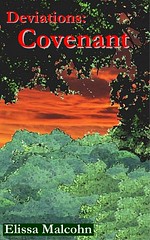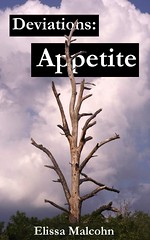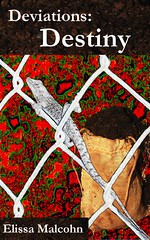Shape-shifting manuscripts

This blog entry comes in conjunction with Coyote Con, a free, month-long digital conference on speculative literature. Kudos to the organizers at Drollerie Press et al. for a great event!
I've published in different genres and in different sizes. The latter includes poetry and micro-poetry, flash fiction and micro-fiction, short stories, novelettes, and novels. The first (not ready for prime time) "novel" I ever wrote could probably qualify as a novella as word counts go. For speculative fiction, the qualifying word counts for short stories up through novels may be found on the SFWA Nebula Rules page -- but check your market for individual specs.
So, given a story idea, how do I know what size it fits into?
Short answer: I often don't.
My novelette "Flotsam" (Asimov's, Oct./Nov. 2009) clocked in at around 2,000 words more than what I'd originally intended, though I hadn't set out to achieve a particular word count. Instead, I thought I knew where the story arc would end. Once I began writing that scene, I realized I needed to add more to achieve the kind of closure I wanted.
In contrast, my other published novelette, "Lazuli" (Asimov's, Nov. 1984), had to be trimmed by about 2,500 words. In that case, I had submitted the longer manuscript. Shawna McCarthy, then editor of Asimov's, suggested the trim, and I cut several scenes that, much as I liked them, were not crucial to the story.
Fortunately, I had kept my old draft -- because Shawna then wanted some of that material put back in. Keeping old drafts is a good idea!
Those examples show how sizes change within pretty much the same narrative format. But what if the format changes entirely?
Generating story ideas is not my problem. Getting those ideas to work is the challenge. Even after I come up with my concept of a beginning, middle, and end, I still get into trouble. It's akin to sketching an invention on paper and trying to build a prototype that then collapses. The unexpected happens during the creation process. A story arc I at first thought was straightforward becomes more complicated. Or I need to do more research than I originally thought and which raises more questions still. Or my tone -- the emotional structure of the story -- is off, like a joke that falls flat.
When my story collapses I have to return to the basics: namely, what am I trying to say? What is my theme? Why did this story idea grab me on a personal level, such that I wanted to tell it? What do I want to impart to my reader?
My poem "The Last Dragon Slayer" is forthcoming in Mythic Delirium, but it didn't start as a poem. It started as a humorous short story. I wrote the first few scenes before I realized I was way off. I felt like a budding comedian who knew she was well on her way to dying on stage. How did I know? I couldn't maintain the tone I wanted and my pacing got all wiggly.
Some weeks later -- after much note-scribbling and twiddling and tearing my hair out -- I gave up on the short story idea and wrote a 102-line story-poem instead. It has a beginning, a middle, and an end. It has a backstory. But in contrast to my aborted fiction, the poem is dark rather than light. It uses an economy of phrase and poetic rhythms that differentiate it from fiction. It works as a poem.
It sent the basic theme I wanted to convey in an entirely different direction. I still haven't given up on using that theme in fiction. I'm toying with another story idea that has a much different plot line than its predecessor and that uses science fiction rather than fantasy tropes.
Saying I get a story idea means I get a story premise. That's my "what if?" My job is to translate that premise into a story, or a poem, or whatever format can carry that idea. Just having a premise alone doesn't cut it.
In 1985 a single, overheard line after a lecture on factory automation got my mental cogwheels turning. I wanted to write a story, but I had no plot, not even a story idea. All I had was a concept I wanted to get across. I first wrote "Labor Intensive," a poem that was published in the Harvard Business Review (Jul./Aug. 1986) and later reprinted in Prof. John K. Shank's case "Jones Ironworks, Inc." The story, "Cog," didn't come to me until two years later, and appeared in Tales of The Unanticipated (Fall/Winter 1988). The two pieces are different in many ways, but claiming one's sense of personal dignity is the underlying theme that they share.
Sometimes I'm "in the zone," where my narrative infrastructure holds together and needs only to be properly dressed. I've drafted stories in a night. But sometimes I find I've put a facade on a house of cards. My ideas are still there, my premise is still there, but I've somehow lost the story and I need to go back and start again.
Sometimes the "story" isn't enough. My Deviations series began as short fiction that I drafted at the end of 1985. Feedback I received for that submission was that the writing was good, my premise was good, but I had to provide more information. That manuscript remained shelved for almost 20 years until I dug it out, kept and polished much of the first half, ditched the second half, and embarked on what I thought was the writing of a novel. Then I thought I'd written a trilogy. Now I know I've written a six-book series.
Writing in different formats uses different parts of my brain, at least figuratively. I spent April (National Poetry Month) writing a sonnet a day, based on science-themed news stories (link inclusive index here). It was good exercise for me in distilling articles down to their core components and fitting those into fourteen rhymed and metered lines in a way that made them both educational and entertaining. Those poems are creative cousins of the abstracts I've generated in my corporate writing. In that way, they differ from my other poems, even from my other sonnets. Some of what I learned from those science articles has also given me ideas to play with in other forms.
"Poetry" itself encompasses far more than a single format. At one end of the spectrum you have Basho's haiku. At the other end of the spectrum you have Homer's Iliad and Odyssey, and modern epic poems like Homero Aridjes's novel-poem Persephone or Ntozake Shange's choreopoem For Colored Girls Who Have Considered Suicide When the Rainbow is Enuf. Different ideas can fit into different poetic forms -- what works in a cinquain sequence might not work in a sestina.
One can dispense with words altogether. Preparations for writing "Arachne" (Aboriginal Science Fiction, Nov./Dec. 1988, reprinted in Riffing on Strings: Creative Writing Inspired by String Theory from Scriblerus Press, 2008) included sketching a very pregnant woman with butterfly wings and antennae. No such character appears in the story or even comes close, but the act of sketching itself allowed the story to come together in my brain. I also carved and played around with spider-shaped stamps and with weaving -- this entry gives a look into what became a thoroughly obsessive creative process. I only recently returned to the sketch I made more than 20 years ago (seen here) and used it to generate the poem "Butterfly Woman," which appears in Goblin Fruit.
For me, the bottom line -- and one of my personal mantras -- is that nothing is wasted. An idea that doesn't gel in one format might gel in another. Or maybe it needs more ingredients (or fewer ingredients) in order to work. (For a great comparison of the writing process to baking bread, see this article by Jennifer St. Clair.)
I write a lot of crap, but in the end it's helpful crap. It's what Natalie Goldberg calls "composting" in her book Writing Down the Bones. She says, "Often I will stab many times at something I want to say. For instance, you can look in my notebooks from August through December 1983 and see that I attempted several times a month to write about my father dying. I was exploring and composting the material. Then suddenly, and I can’t say how, in December I sat transfixed at the Croissant Express in Minneapolis and a long poem about that subject poured out of me. All the disparate things I had to say were suddenly fused with energy and unity -- a bright red tulip shot out of the compost. Katagiri Roshi said: 'Your little will can’t do anything. It takes Great Determination. Great Determination doesn’t mean just you making an effort. It means the whole universe is behind you and with you -- the birds, trees, sky, moon, and ten directions.' Suddenly, after much composting, you are in alignment with the stars or the moment or the dining-room chandelier above your head, and your body opens and speaks."
Play around with different formats. If something's not working, try re-casting it. That process in and of itself can loosen blockages and grow ideas into finished products.

 |  |  |
 | Go to Manybooks.net to access Covenant, Appetite, and Destiny in even more formats! |
 | Participant, Operation E-Book Drop. (Logo credit: K.A. M'Lady & P.M. Dittman.) |











0 Comments:
Post a Comment
<< Home